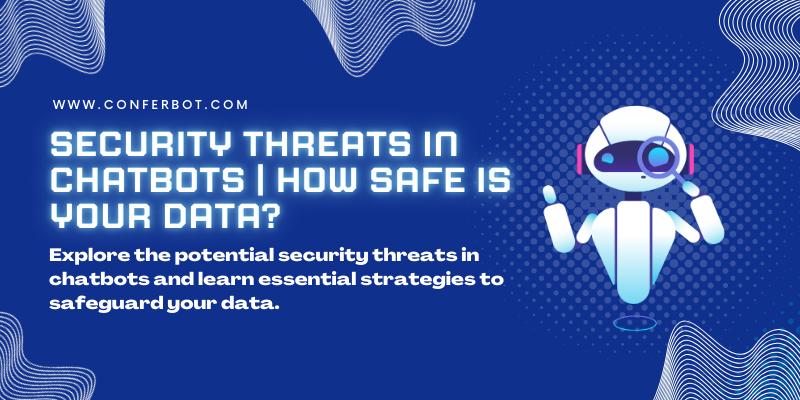Chatbots aid people from different fields, mainly to help in reducing the manpower required for simple and repetitive tasks. These chatbots provide AI assistance to customers be it assistant bots, support chatbots, skill chatbots, and transactional bots. But is the information you share via a chatbot safe? One may have to share a variety of personal data with a chatbot depending on the type of bot you are conversing with, and how do you know if the data that you are sharing is going to the right person. There are several ways to secure the data that is being shared via chatbots, let’s have a look at a few.
Security Threats in Chatbots | How safe is your data?

Just like any application chatbots are also prone to attack from hackers but that does not mean it has to happen. There are ways in which you can protect your clients and your information from reaching the wrong hands. First, let’s go over a few types of attacks that chatbots are generally prone to.
- Phishing
- Whaling
- Impersonation of individuals
- Ransomware
- Malware
- Data-theft
- Data alterations
How to protect your data?
Authentication and authorisation
Chatbots use two main security processes – authentication (user identity verification) and authorisation (granting permission for a user to access a portal or carry out a certain task). The most effective defensive security measures utilise both authentication and authorisation. Specific measures include:
- Biometric authentication: Iris scans and fingerprint scans are increasingly popular and, thanks to developments in biometrics in general, are much more robust.
- Two-factor authentication: Users are required to verify their identity through two separate channels. This is pretty ‘old school’, but sometimes tried and tested methods like this are the best form of defense. Two-factor authentication is still used by many financial institutions, including banks.
- User ID: the most familiar method of security to the average digital customer. User IDs involve creating secure login credentials, including passwords that are not pet’s names or just the word ‘password!’
- Authentication Timeouts: A ‘ticking clock’ for correct authentication input can prevent repeated attempts by hackers to try and guess their way into a secure account.

Encryption
End-to-end encryption stops anyone other than the sender and recipient from seeing any part of the message. This is being widely adopted by Chatbot designers and is without a doubt one of the most robust methods of ensuring Chatbot security. It’s a key feature of chat services like WhatsApp and large tech developers have been keen to guarantee the security of such encryption, even when challenged by national governments.

Education
The one security vulnerability that is sure to occur and out of technical control is human error. With commercial applications, in particular, user behavior has to be addressed. Otherwise, the system is fundamentally flawed. Though the importance of digital security is recognized by an increasing number of users, humans are still the weakest link in the system. Chatbot security will continue to be a problem until the issue of user error ceases to exist. This will require widespread education on how digital technologies like Chatbots can be used securely.

Employees also have the same chance of making a mistake just as much as customers. To avoid this risk, involve developers and IT specialists in your chatbot development strategy, who will instruct your employees on how to utilize the system safely. This not only improves your team's skill set but also provides them the confidence to safely interact with the Chatbot system.

Customers cannot be ‘trained’ in the same way as your staff, but they can be given a roadmap detailing how to interact with the system safely. This may involve bringing on board other professionals, such as copywriters, who can create informative newsletters, online content ,or direct digital mailouts that engage customers and inform them of the right way to interact with your Chatbots.
Processes and protocols
The default setting for any security system is the HTTPS protocol. As long as your IT security teams are ensuring your data is being transferred over HTTP through encrypted connections protected by Transport Layer Security (TLS) or Secure Sockets Layer (SSL), then there shouldn’t be any problems. This should keep any potential back-door to your business system tightly shut.

The key thing to remember with Chatbot security is that while Chatbots are relatively new, the protocols, systems, and coding used to protect them are almost identical to that in existing HIMs. They interact across platforms that already have their internal security systems and, from the outset, there is more than one layer of encryption and security to protect users.

At Conferbot we prioritize users’ privacy and take all necessary measures to ensure the safety of our users’ data. Conferbot is GDPR compliant. GDPR stands for General Data Protection Regulation.

Build your own chatbot for business and personal needs with zero coding knowledge with Conferbot. Start building your chatbot right now for free.
Why Conferbot? They use machine learning algorithms that improve with every conversation and sound more natural and personalized than ever. You can build your customised chatbot without any coding with simple drag and drop facilities.
Similar blogs:
https://blog.24by7security.com/five-chatbot-security-measures-you-can-implement-in-house
Visit Conferbot - https://conferbot.com

